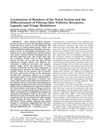TLDR Delta1 is crucial for controlling skin cell growth and preventing tumors in mice.
The study examined the role of the Notch ligand Delta1 (Dll1) in mouse epidermis, finding that Dll1 was crucial for regulating interfollicular epidermis (IFE) proliferation and differentiation, but not essential for maintaining adult hair follicles. Deletion of Dll1 led to increased IFE proliferation, disturbed keratin marker expression, and epidermal tumor formation in older mice, indicating a role in tumor suppression. Dll1-null keratinocytes showed increased proliferation and differentiation in vitro. The study highlighted distinct roles for Dll1 and Jagged1, with Dll1 primarily affecting IFE dynamics and Jagged1 more involved in hair follicle differentiation.
 62 citations
,
January 2000 in “Developmental dynamics”
62 citations
,
January 2000 in “Developmental dynamics” Notch-related genes play a key role in the development and cycling of hair follicles.
318 citations
,
October 1998 in “The Journal of Cell Biology” The study investigated the expression of keratin 17 (K17) during mouse skin development, revealing that K17 synthesis began in embryonic day 10.5 in a subset of epithelial cells. These cells later formed placodes, precursors to ectoderm-derived appendages like hair, glands, and teeth. The spatial distribution of K17 corresponded with lymphoid-enhancer factor (lef-1), a protein involved in epithelial–mesenchymal interactions. Ectopic expression of lef-1 in adult transgenic mice induced K17, suggesting a link between K17 expression, skin morphogenesis, and wound repair. This research highlighted the role of K17 in skin development and its potential involvement in epithelial lineage definition.
150 citations
,
May 1993 in “The journal of cell biology/The Journal of cell biology” Mouse Notch is important for determining cell roles in hair follicles.
50 citations
,
July 2008 in “British Journal of Dermatology” 138 citations
,
March 2007 in “Experimental cell research” Only a few hair-specific keratins are linked to inherited hair disorders.
276 citations
,
January 2005 in “International review of cytology” 199 citations
,
January 2004 in “The International Journal of Developmental Biology” Hair follicle growth and development are controlled by specific genes and molecular signals.
29 citations
,
April 2003 in “Experimental dermatology” Human hair follicles grown in vitro maintain normal keratin patterns and structure.

